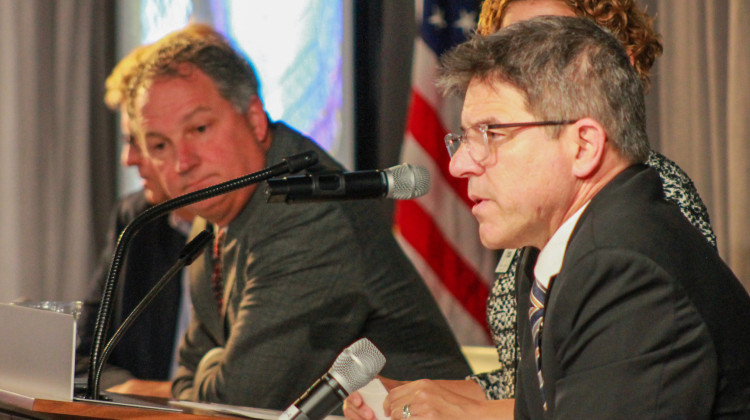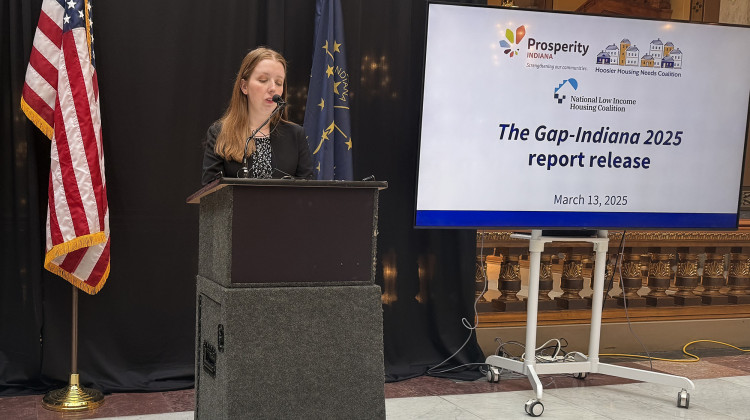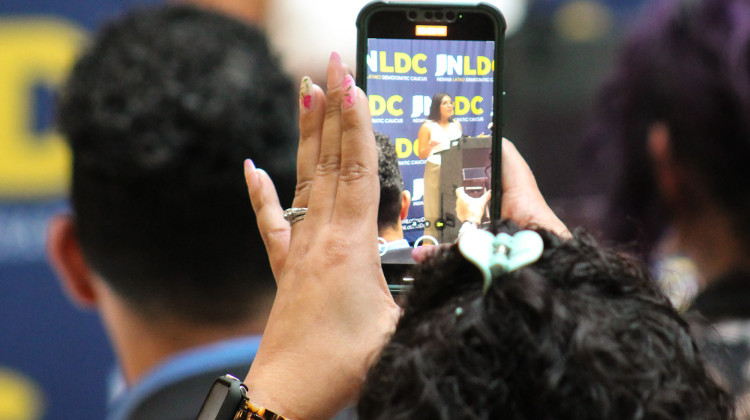
Indiana currently only offers the self-direction option to a small number of people with physical disabilities.
Lauren Chapman/IPB NewsState officials will soon create and implement a registry of direct support professionals (DSP) who provide in-home care to people with mental and developmental disabilities. The goal is to use the new system to begin tracking allegations of abuse and neglect by DSPs.
The new law, HEA 1342, is a hard-fought victory for the bill’s author and supporters.
But some disabled advocates, like Loren Pilcher, say it only partly addresses systemic issues that can harm workers and clients alike. Pilcher is a key strategic consultant for Disability Revolution, a disability consulting firm “ delivering equitable, inclusive, comprehensive solutions” to nonprofits, small businesses, corporations and government entities.
“Disabled people need to be in the driver's seat, not a provider, not a loved one. They need to be directing their own care,” Pilcher said.
Pilcher used to hire DSPs in his former role as chief operating officer of a southern Indiana care provider agency. He also often worked as a DSP for that agency “because of the staffing shortage.”
It goes beyond DSPs: certified nursing assistants, personal care aides and other types of “direct service workers” (DSWs) also struggle with a staffing shortage, low wages, unchecked abuse and neglect, insufficient training and more, according to Pilcher and other advocates.
“I think [the new law] may help the staffing process a little bit … What I know would really help is raising the wages of direct support workers,” he said. “And this new system that's coming in Indiana called ‘self-direction,’ where you remove the provider from the equation, where the person with the disability is actually directing all of their services.”
Currently, people with disabilities in Indiana can get state funds through waivers that help pay for in-home care, therapies and other services. For most, those funds go to provider agencies that are responsible for hiring and managing the people who work to meet the recipients’ care needs.
Some agencies do let clients choose their workers, particularly if the client has family members or loved ones who can provide care. But, Pilcher said self-directed care gives a more significant degree of control.
How self-direction can help
Along with the benefits of respecting people with disabilities' right to self-determination, Pilcher said there is potential financial gain under self-directed care. There hasn't been much research on how costs shift in self-directed care compared to the alternatives, according to the National Council on Disability. Studies that do exist have “yielded inconclusive and sometimes contradictory results.”
“The way Medicaid providers work is there's a set rate for the work that we do,” he said. “Companies can only go so high when they're paying folks. And there are administrative tasks that have to be done. There is overhead that has to be there. So if you can utilize self-direction and take the provider out of the equation, you would instantly get more money in the hands of direct service workers.”
There are several steps the state would have to take to get to that point. Indiana currently only offers the self-direction option to a small number of people, including attorney and Indiana Disability Rights Policy Director Emily Munson.
“I have the authority to hire and fire individual caregivers as I wish,” Munson said. “It's only available currently to people with physical disabilities. The state is working on expanding it to folks with intellectual disabilities, traumatic brain injuries, mental illness and so forth.”
For Munson, self-directed care allows her to ensure she hires a caretaker that meets her standards, which may be different than an agency's standards.
“I've always said I would rather hire someone off the street than a nurse to get my care,” Munson said. “Because the less someone comes in knowing, the more I believe they listen and you can train them to meet your own needs.”
Munson, Pilcher and a group of other advocates have been working with the Family and Social Services Administration to make self-directed care an option for more people. FSSA declined an interview request but a spokesperson confirmed the administration is “exploring the expansion” of self-directed care.
It’s not clear how many people currently use the option in Indiana.
Munson agrees that self-directed care can be a pathway to better wages for DSWs, which can make the job more competitive and attract better workers. But, she said there are limitations that prevent her from actually using the money she gets from Medicaid to give a wage increase, even though she “technically” should be able to.
Munson said she’s had to pay out of her own pocket to give a caregiver a raise beyond the base pay provided through the state.
“If they take great direction from me and are reliable and are with me for a good stretch of time … I want to demonstrate my gratitude with better wages,” she said. “I am also significantly physically disabled, and getting me up or putting me to bed takes pretty significant physical effort. That heavy labor should also be rewarded with a greater wage than just sitting around my house in the afternoon, doing whatever the caregiver wants while waiting for me to ask for a pill or a drink every hour or so.”
Join the conversation and sign up for the Indiana Two-Way. Text "Indiana" to 73224. Your comments and questions in response to our weekly text help us find the answers you need on statewide issues.
Guaranteeing people in self-directed care the ability to set their own wages is part of the ongoing expansion discussion with FSSA, according to Nancy Griffin.
Griffin is now retired, but the 70-year-old worked to expand self-directed care for years as a former director of both the Indiana AARP and Indianapolis Resource Center for Independent Living as well as other roles.
“It'll have to be approved by the state budget agency, and it'll have to be vetted by the federal Medicaid office,” Griffin said. “So we've got a ways to go, but we are making the argument that should be the case.”
Getting past “the holdup”
Self-directed care used to be more the norm, Griffin said.
“A lot of people who receive care through Medicaid don't receive much care. It's just a few hours a day, perhaps, or even just a few hours per week,” she said. “And for most of those people, for a long time, they just hired their neighbor or their sister or a friend because there weren't these big agency conglomerates with lots of control over the money in the system.”
Griffin said she believes part of “the holdup” preventing more people from accessing self-directed care may be a fear providers have that “they'll go out of business if everybody can just hire their own folks.” But she’s confident that Indiana will soon start offering self-directed care to more people as several other states have already done for years.
“I think we're going to get an expanded pool of opportunity for some people. I'm not sure how broad it's going to be to start. We want it for everybody,” she said. “Not that everybody has to use it. There's nothing wrong with care providers from agencies in most cases. Sometimes there is, but not always. But it should be an option.”
The Indiana Association of Rehabilitation Facilities (INARF), which represents many of the state’s care providers, “does not have a formal position on self-directed care,” said CEO Katy Stafford-Cunningham, in an email. “But INARF and our Members strongly believe in person-centered supports and doing what is best for the individual.”
Like Griffin, Loren Pilcher of Disability Revolution does not believe an expansion of self-directed care would spell doom for agencies like his former employer. He points to California as an example of a model that allows self-direction and providers to coexist.
“We should naturally grow and we shouldn't ever, ever be against anything that puts people with disabilities in the driver's seat. We just shouldn't,” he said. “And if that means that a part of the business is lost, it means that a part of the business is lost. We're all smart people. We'll find something else to do.”
Adam is our labor and employment reporter. Contact him at arayes@wvpe.org or follow him on Twitter at @arayesIPB.
9(MDAyMzk1MzA4MDE2MjY3OTY1MjM5ZDJjYQ000))
 DONATE
DONATE








 Support WFYI. We can't do it without you.
Support WFYI. We can't do it without you.